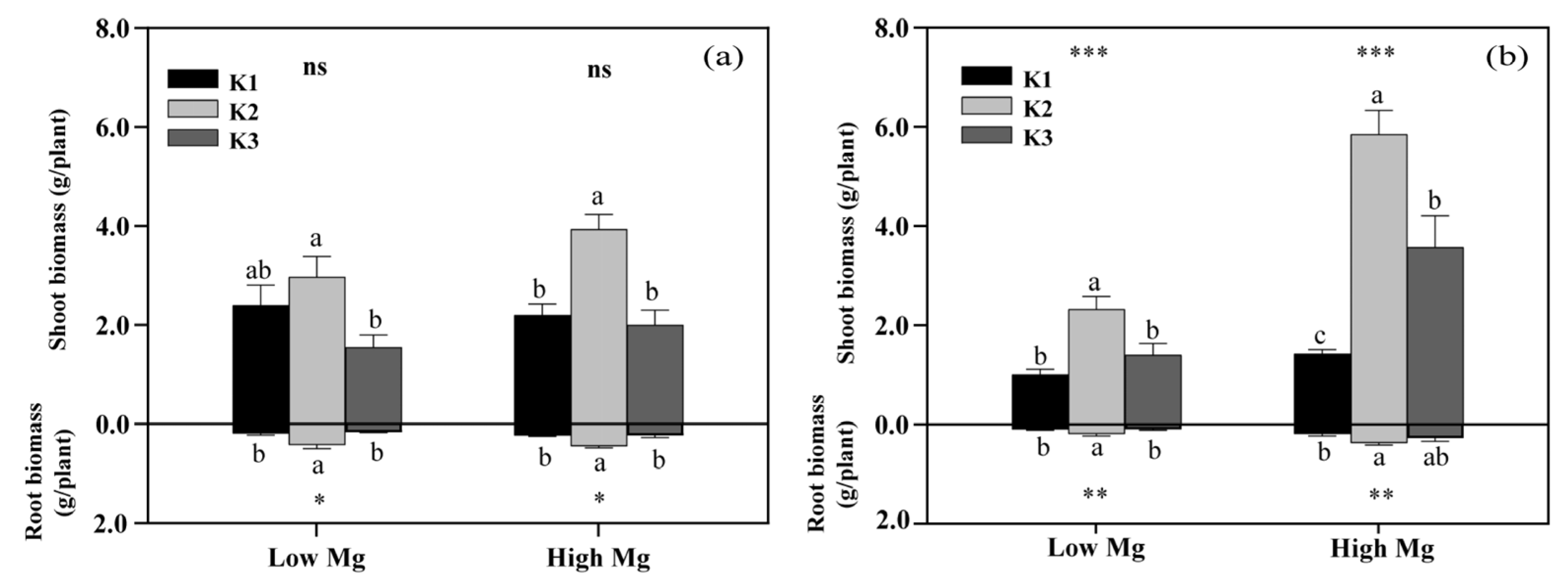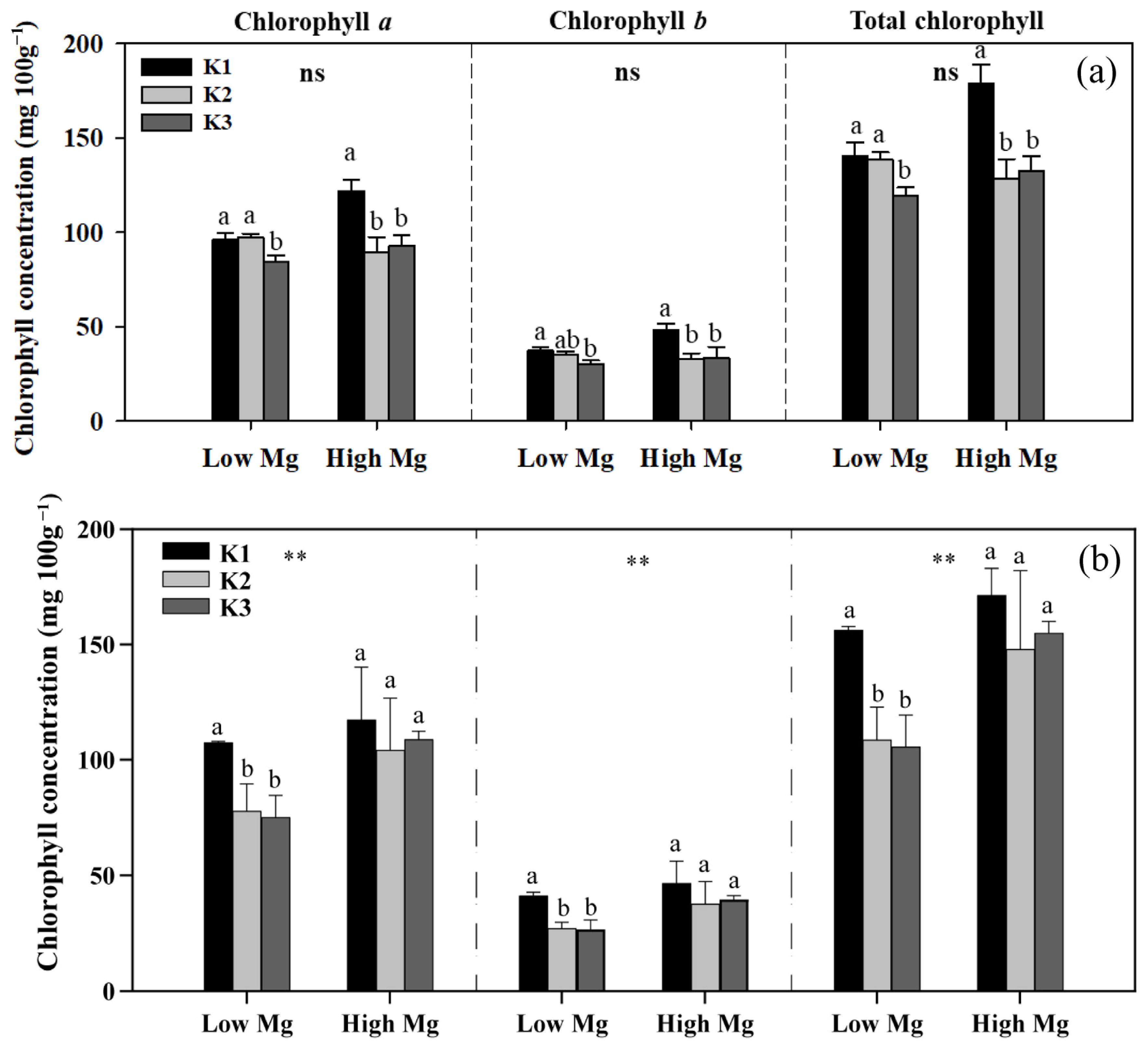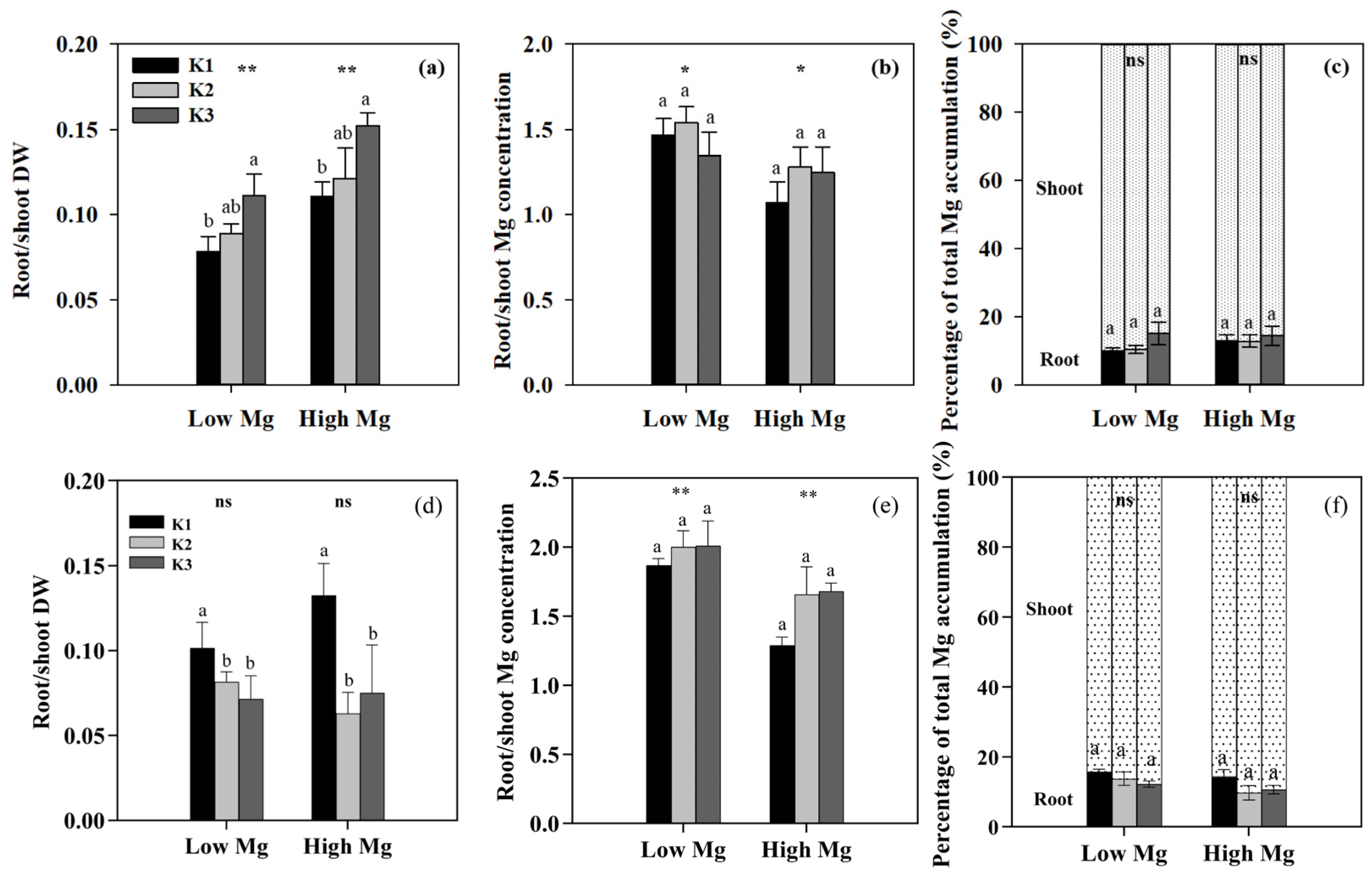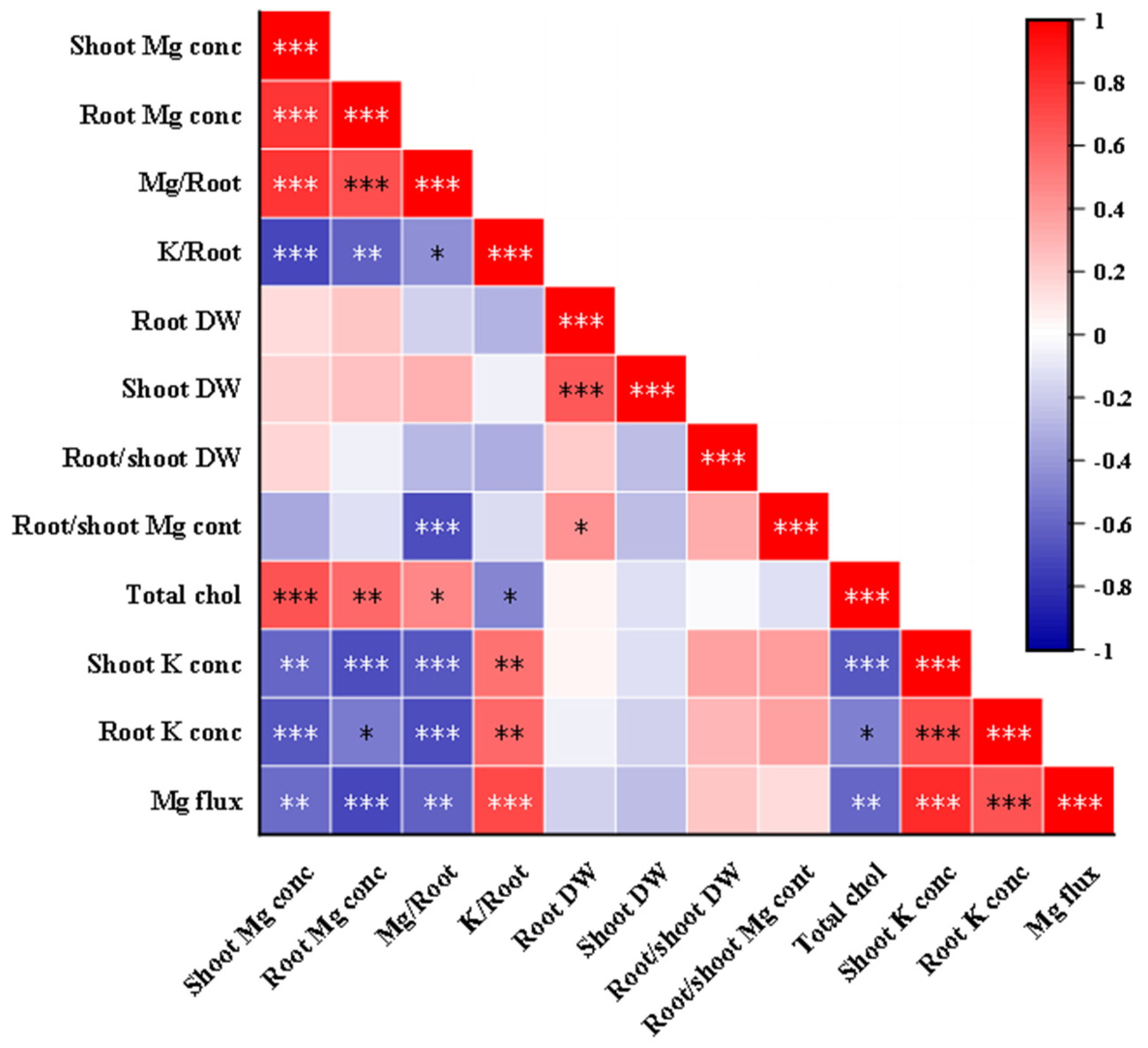Compared to MgSO4, the Use of Magnesium Nanofertilizer Alleviates Potassium-Magnesium Antagonism in Tomato Roots
Abstract
1. Introduction
2. Materials and Methods
2.1. Characterization of a Mg(OH)2 Nanomaterial
2.2. Experimental Design
2.3. Sample Collection and Analysis
2.3.1. Sample Collection
2.3.2. K and Mg Analyses
2.3.3. Chlorophyll Determination
2.3.4. Net Mg2+ Flux into Roots
2.3.5. Statistical Analyses
3. Results
3.1. Impacts of K and Mg Supply on Tomato Growth
3.2. Impacts of K and Mg Supply on K and Mg Nutrient Status in Different Parts of Tomato Seedlings
3.3. Correlation Analysis of Indicators Related to K–Mg Antagonism
3.4. Impact of Mg Nanofertilizer on Tomato Growth and K and Mg Nutrition Status
4. Discussion
4.1. Impacts of K and Mg Supply Rates on Tomato Seedling Growth
4.2. Root-Specific K–Mg Antagonism in Tomato Plants
4.3. Alleviation of K–Mg Antagonism by Mg Nanofertilizer Application
5. Conclusions
Author Contributions
Funding
Institutional Review Board Statement
Data Availability Statement
Conflicts of Interest
References
- Cakmak, I.; Yazici, A.M. Magnesium: A forgotten element in crop production. Better Crop. 2010, 94, 23–25. [Google Scholar]
- He, Z.; Shang, X.; Zhang, T.; Yun, J. Effect of calcium and magnesium on starch synthesis in maize kernels and its physiological driving mechanism. Front. Plant Sci. 2024, 14, 1332517. [Google Scholar] [CrossRef] [PubMed]
- Wang, Z.; Hassan, M.U.; Nadeem, F.; Wu, L.; Zhang, F.; Li, X. Magnesium fertilization improves crop yield in most production systems: A Meta-analysis. Front. Plant Sci. 2020, 10, 495191. [Google Scholar] [CrossRef] [PubMed]
- Ishfaq, M.; Wang, Y.; Yan, M.; Wang, Z.; Wu, L.; Li, C.; Li, X. Physiological essence of magnesium in plants and its widespread deficiency in the farming system of China. Front. Plant Sci. 2022, 13, 802274. [Google Scholar] [CrossRef] [PubMed]
- Mayland, H.F.; Wilkinson, S.R. Soil factors affecting magnesium availability in plant-animal systems: A review. J. Anim. Sci. 1989, 67, 3437–3444. [Google Scholar] [CrossRef]
- Maathuis, F.J. Physiological functions of mineral macronutrients. Curr. Opin. Plant Biol. 2009, 12, 250–258. [Google Scholar] [CrossRef]
- Mengel, K.; Kirkby, E.A.; Kosegarten, H.; Appel, T. The soil as a plant nutrient medium. In Principles of Plant Nutrition; Mengel, K., Kirkby, E.A., Kosegarten, H., Appel, T., Eds.; Springer: Cham, Switzerland, 2001; pp. 15–110. [Google Scholar] [CrossRef]
- Xie, K.; Cakmak, I.; Wang, S.; Zhang, F.; Guo, S. Synergistic and antagonistic interactions between potassium and magnesium in higher plants. Crop J. 2021, 9, 249–256. [Google Scholar] [CrossRef]
- Fei, C.; Zhang, S.; Sun, Z.; Ding, X. Assessment of magnesium deficiency in greenhouse tomato crops grown on calcareous soil. Soil Use Manag. 2024, 40, e12939. [Google Scholar] [CrossRef]
- Shamhari, N.M.; Wee, B.S.; Chin, S.F.; Kok, K.Y. Synthesis and characterization of zinc oxide nanoparticles with small particle size distribution. Acta Chim. Slov. 2018, 65, 578–585. [Google Scholar] [CrossRef]
- Shukla, U.; Mukhi, A.K. Sodium, potassium, and zinc relationship in Corn1. Agron. J. 1979, 71, 235–237. [Google Scholar] [CrossRef]
- Rhodes, R.; Miles, N.; Hughes, J.C. Interactions between potassium, calcium and magnesium in sugarcane grown on two contrasting soils in South Africa. Field Crop. Res. 2018, 223, 1–11. [Google Scholar] [CrossRef]
- Dibb, D.W.; Thompson, W.R., Jr. Interaction of potassium with other nutrients. In Potassium Agric; Munson, R.D., Ed.; American Society of Agronomy: Madison, WI, USA, 1985; pp. 515–533. [Google Scholar] [CrossRef]
- Ologunde, O.O.; Sorensen, R.C. Influence of concentrations of K and Mg in nutrient solutions on sorghum1. Agron. J. 1982, 74, 41–46. [Google Scholar] [CrossRef]
- Hovland, D.; Caldwell, A.C. Potassium and magnesium relationships in soils and plants. Soil Sci. 1960, 89, 92–96. [Google Scholar] [CrossRef]
- Addiscott, T.M. Potassium and the distribution of calcium and magnesium in potato plants. J. Sci. Food Agric. 1974, 25, 1173–1183. [Google Scholar] [CrossRef]
- Tisdale, S.L.; Nelson, W.L.; Beaton, J.D. Soil Fertility and Fertilizers; Collier Macmillan Publishers: New York, NY, USA, 1985. [Google Scholar]
- Reuter, D.; Robinson, J.B. (Eds.) Plant Analysis: An Interpretation Manual; CSIRO Publishing: Melbourne, Australia, 1997. [Google Scholar] [CrossRef]
- Guan, X.; Liu, D.; Liu, B.; Wu, C.; Liu, C.; Wang, X.; Zou, C.; Chen, X. Critical leaf magnesium concentrations for adequate photosynthate production of soilless cultured cherry tomato—Interaction with potassium. Agronomy 2020, 10, 1863. [Google Scholar] [CrossRef]
- Rietra, R.P.; Heinen, M.; Dimkpa, C.O.; Bindraban, P.S. Effects of nutrient antagonism and synergism on yield and fertilizer use efficiency. Commun. Soil Sci. Plant Anal. 2017, 48, 1895–1920. [Google Scholar] [CrossRef]
- Gransee, A.; Führs, H. Magnesium mobility in soils as a challenge for soil and plant analysis, magnesium fertilization and root uptake under adverse growth conditions. Plant Soil 2013, 368, 5–21. [Google Scholar] [CrossRef]
- Tränkner, M.; Jákli, B.; Tavakol, E.; Geilfus, C.M.; Cakmak, I.; Dittert, K.; Senbayram, M. Magnesium deficiency decreases biomass water-use efficiency and increases leaf water-use efficiency and oxidative stress in barley plants. Plant Soil 2016, 406, 409–423. [Google Scholar] [CrossRef]
- Wang, X.; Gao, Y.; Hu, B.; Chu, G. Comparison of the Hydrolysis Characteristics of three polyphosphates and their effects on soil phosphorus and micronutrient availability. Soil Use Manag. 2019, 35, 664–674. [Google Scholar] [CrossRef]
- Hu, L.; Huang, R.; Zhou, L.; Qin, R.; He, X.; Deng, H.; Li, K. Effects of magnesium-modified biochar on soil organic carbon mineralization in citrus orchard. Front. Microbiol. 2023, 14, 1109272. [Google Scholar] [CrossRef]
- Shenker, M.; Chen, Y. Increasing Iron Availability to Crops: Fertilizers, organo-fertilizers, and biological approaches. Soil Sci. Plant Nutr. 2005, 51, 1–17. [Google Scholar] [CrossRef]
- El-Shal, R.M.; El-Naggar, A.H.; El-Beshbeshy, T.R.; Mahmoud, E.K.; El-Kader, N.I.A.; Missaui, A.M.; Du, D.; Ghoneim, A.M.; El-Sharkawy, M.S. Effect of nano-fertilizers on alfalfa plants grown under different salt stresses in hydroponic system. Agriculture 2022, 12, 1113. [Google Scholar] [CrossRef]
- Elsayed, A.A.; Ahmed, E.G.; Taha, Z.K.; Farag, H.M.; Hussein, M.S.; AbouAitah, K. Hydroxyapatite nanoparticles as novel nano-fertilizer for production of rosemary plants. Sci. Hortic. 2022, 295, 110851. [Google Scholar] [CrossRef]
- Seleiman, M.F.; Almutairi, K.F.; Alotaibi, M.; Shami, A.; Alhammad, B.A.; Battaglia, M.L. Nano-fertilization as an emerging fertilization technique: Why can modern agriculture benefit from its use? Plants 2021, 10, 2. [Google Scholar] [CrossRef]
- Subramanian, K.S.; Manikandan, A.; Thirunavukkarasu, M.; Rahale, C.S. Nano-fertilizers for balanced crop nutrition. In Nanotechnologies in Food and Agriculture; Rai, M., Ribeiro, C., Mattoso, L., Duran, N., Eds.; Springer International Publishing: Cham, Switzerland, 2015; pp. 69–80. [Google Scholar] [CrossRef]
- Savvas, D.; Ntatsi, G.; Passam, H.C. Plant nutrition and physiological disorders in greenhouse grown tomato, pepper and eggplant. Eur. J. Plant Sci. Biotechnol. 2008, 2, 45–61. [Google Scholar]
- Arnon, D.I. Copper enzymes in isolated chloroplasts. Polyphenoloxidase in beta vulgaris. Plant Physiol. 1949, 24, 1. [Google Scholar] [CrossRef]
- Liu, B.; Zhang, J.; Ye, N. Noninvasive micro-test technology: Monitoring ion and molecular flow in plants. Trends Plant Sci. 2023, 28, 123–124. [Google Scholar] [CrossRef]
- Yan, B.; Zhou, T.; Wang, H.M.; Chen, Z.J.; Cao, J.Y.; Liu, S.M. The relationships between magnesium deficiency of tomato and cation balances in solar greenhouse soil. Sci. Agric. Sin. 2016, 49, 3588–3596, (In Chinese with English abstract). [Google Scholar] [CrossRef]
- Shabala, S.; Hariadi, Y. Effects of magnesium availability on the activity of plasma membrane ion transporters and light-induced responses from broad bean leaf mesophyll. Planta 2005, 221, 56–65. [Google Scholar] [CrossRef]
- Ishfaq, M.; Zhong, Y.; Wang, Y.; Li, X. Magnesium limitation leads to transcriptional down-tuning of auxin synthesis, transport, and signaling in the tomato root. Front. Plant Sci. 2021, 12, 802399. [Google Scholar] [CrossRef]
- Fageria, N.K. Ionic interactions in rice plants from dilute solutions. Plant Soil 1983, 70, 309–316. Available online: http://www.jstor.org/stable/42934193 (accessed on 2 November 2024). [CrossRef]
- del Amor, F.M.; Rubio, J.S. Effects of antitranspirant spray and potassium: Calcium: Magnesium ratio on photosynthesis, nutrient and water uptake, growth, and yield of sweet pepper. J. Plant Nutr. 2009, 32, 97–111. [Google Scholar] [CrossRef]
- Li, H.X.; Chen, Z.J.; Zhou, T.; Liu, Y.; Zhou, J.B. High potassium to magnesium ratio affected the growth and magnesium uptake of three tomato (Solanum lycopersicum L.) cultivars. J. Integr. Agric. 2018, 17, 2813–2821. [Google Scholar] [CrossRef]
- Ruiz, J.M.; Moreno, D.A.; Romero, L. Pyruvate kinase activity as an indicator of the level of K+, Mg2+, and Ca2+ in leaves and fruits of the cucumber: The role of potassium fertilization. J. Agric. Food Chem. 1999, 47, 845–849. [Google Scholar] [CrossRef]
- Hariadi, Y.; Shabala, S. Screening broad beans (Vicia faba) for magnesium deficiency. I. Growth characteristics, visual deficiency symptoms and plant nutritional status. Funct. Plant Biol. 2004, 31, 529–537. [Google Scholar] [CrossRef]
- Dai, B.; Chen, C.; Liu, Y.; Liu, L.; Qaseem, M.F.; Wang, J.; Li, H.; Wu, A.M. Physiological, biochemical, and transcriptomic responses of neolamarckia cadamba to aluminum stress. Int. J. Mol. Sci. 2020, 21, 9624. [Google Scholar] [CrossRef]
- Connolly, E.L.; Campbell, N.H.; Grotz, N.; Prichard, C.L.; Guerinot, M.L. Overexpression of the FRO2 ferric chelate reductase confers tolerance to growth on low iron and uncovers posttranscriptional control. Plant Physiol. 2003, 133, 1102–1110. [Google Scholar] [CrossRef]
- Koch, M.; Busse, M.; Naumann, M.; Jákli, B.; Smit, I.; Cakmak, I.; Hermans, C.; Pawelzik, E. Differential effects of varied potassium and magnesium nutrition on production and partitioning of photoassimilates in potato plants. Physiol. Plant. 2019, 166, 921–935. [Google Scholar] [CrossRef]
- Kabu, K.; Toop, E.W. Influence of potassium-magnesium antagonism on tomato plant growth. Can. J. Plant Sci. 1970, 50, 711–715. [Google Scholar] [CrossRef][Green Version]
- Tang, Y.; Yang, X.; Li, H.; Shuai, Y.; Chen, W.; Ma, D.; Lü, Z. Uncovering the role of wheat magnesium transporter family genes in abiotic responses. Front. Plant Sci. 2023, 14, 1078299. [Google Scholar] [CrossRef]
- Chen, Z.C.; Peng, W.T.; Li, J.; Liao, H. Functional dissection and transport mechanism of magnesium in plants. Semin. Cell Dev. Biol. 2018, 74, 142–152. [Google Scholar] [CrossRef] [PubMed]
- Chen, L.; Hu, Z.; Chen, W.; Xu, Z.; Hao, C.; Lakshmanan, P.; Liu, D.; Chen, X. Comparative study of the effectiveness of nano-sized iron-containing particles as a foliar top-dressing of peanut in rainy conditions. Agric. Water Manag. 2023, 286, 108392. [Google Scholar] [CrossRef]
- Sun, X.D.; Yuan, X.Z.; Jia, Y.; Feng, L.J.; Zhu, F.P.; Dong, S.S.; Liu, J.; Kong, X.; Tian, H.; Duan, J.L.; et al. Differentially charged nanoplastics demonstrate distinct accumulation in Arabidopsis thaliana. Nat. Nanotechnol. 2020, 15, 755–760. [Google Scholar] [CrossRef] [PubMed]
- Liu, R.; Lal, R. Potentials of engineered nanoparticles as fertilizers for increasing agronomic productions. Sci. Total Environ. 2015, 514, 131–139. [Google Scholar] [CrossRef]
- Yang, J.; Cao, W.; Rui, Y. Interactions between nanoparticles and plants: Phytotoxicity and defense mechanisms. J. Plant Interact. 2017, 12, 158–169. [Google Scholar] [CrossRef]
- Hillaireau, H. Investigating interactions between nanoparticles and cells: Internalization and intracellular trafficking. In Polymer Nanoparticles for Nanomedicines: A Guide for their Design, Preparation and Development; Vauthier, C., Ponchel, G., Eds.; Springer International Publishing: Cham, Switzerland, 2016; pp. 291–323. [Google Scholar] [CrossRef]
- Shinde, S.; Paralikar, P.; Ingle, A.P.; Rai, M. Promotion of seed germination and seedling growth of Zea mays by magnesium hydroxide nanoparticles synthesized by the filtrate from Aspergillus niger. Arabian J. Chem. 2020, 13, 3172–3182. [Google Scholar] [CrossRef]
- Wu, S.; Shi, K.; Hu, C.; Guo, J.; Tan, Q.; Sun, X. Non-invasive microelectrode cadmium flux measurements reveal the decrease of cadmium uptake by zinc supply in pakchoi root (Brassica chinensis L.). Ecotoxicol. Environ. Saf. 2019, 168, 363–368. [Google Scholar] [CrossRef]
- Tarafdar, J.C.; Raliya, R.; Rathore, I. Microbial synthesis of phosphorous nanoparticle from tri-calcium phosphate using aspergillus tubingensis TFR-5. J. Bionanosci. 2012, 6, 84–89. [Google Scholar] [CrossRef]









| Treatments | Shoot Nutrient Concentration (mg g−1) | Root Nutrient Concentration (mg g−1) | Shoot Nutrient Accumulation (mg plant−1) | Root Nutrient Accumulation (mg plant−1) | |||||
|---|---|---|---|---|---|---|---|---|---|
| Mg | K | Mg | K | Mg | K | Mg | K | ||
| Low Mg (in MgSO4) | K1 | 2.10 ± 0.09 a | 41.7 ± 2.89 c | 3.05 ± 0.08 a | 31.3 ± 2.62 b | 5.19 ± 1.09 a | 97.9 ± 11.7 b | 0.57 ± 0.10 ab | 5.69 ± 0.76 b |
| K2 | 1.55 ± 0.08 b | 83.6 ± 5.31 b | 2.40 ± 0.25 b | 40.8 ± 3.33 a | 4.87 ± 0.77 a | 260 ± 37.7 a | 0.82 ± 0.13 a | 13.7 ± 1.47 a | |
| K3 | 1.42 ± 0.04 b | 96.9 ± 3.07 a | 1.91 ± 0.17 b | 45.2 ± 2.67 a | 2.19 ± 0.34 b | 149 ± 22.3 b | 0.31 ± 0.01 b | 7.37 ± 0.58 b | |
| High Mg (in MgSO4) | K1 | 3.94 ± 0.26 a | 43.9 ± 1.78 c | 4.12 ± 0.23 a | 28.5 ± 3.00 b | 8.59 ± 1.27 ab | 93.1 ± 7.03 c | 0.99 ± 0.16 b | 6.82 ± 1.22 b |
| K2 | 2.78 ± 0.08 b | 73.5 ± 1.63 b | 3.55 ± 0.32 a | 37.4 ± 1.69 ab | 10.9 ± 1.26 a | 288 ± 33.0 a | 1.61 ± 0.20 a | 17.1 ± 1.95 a | |
| K3 | 2.27 ± 0.24 b | 89.8 ± 3.75 a | 2.72 ± 0.08 b | 45.0 ± 4.90 a | 4.74 ± 1.19 b | 184 ± 32.5 b | 0.64 ± 0.12 b | 10.9 ± 2.68 ab | |
| Low Mg (in nano-Mg) | K1 | 0.99 ± 0.03 a | 35.8 ± 1.37 b | 1.85 ± 0.01 a | 20.5 ± 3.48 b | 0.98 ± 0.08 b | 35.7 ± 8.31 b | 0.18 ± 0.01 b | 2.09 ± 0.48 c |
| K2 | 1.06 ± 0.04 a | 88.8 ± 4.01 a | 2.12 ± 0.18 a | 50.4 ± 2.81 a | 2.45 ± 0.21 a | 172.0 ± 3.86 a | 0.39 ± 0.07 a | 14.1 ± 0.86 a | |
| K3 | 1.12 ± 0.05 a | 90.2 ± 5.87 a | 2.22 ± 0.09 a | 48.6 ± 4.28 a | 1.58 ± 0.29 b | 198.3 ± 18.1 a | 0.21 ± 0.03 b | 5.53 ± 0.66 b | |
| High Mg (in nano-Mg) | K1 | 2.33 ± 0.04 a | 38.7 ± 4.33 b | 2.99 ± 0.10 ab | 22.9 ± 2.33 b | 3.31 ± 0.16 b | 43.6 ± 12.5 c | 0.57 ± 0.12 b | 4.19 ± 0.57 b |
| K2 | 2.09 ± 0.11 a | 74.0 ± 5.59 a | 3.41 ± 0.28 a | 43.2 ± 2.14 a | 12.3 ± 1.60 a | 345 ± 5.81 a | 1.29 ± 0.22 a | 11.6 ± 3.71 a | |
| K3 | 1.66 ± 0.09 b | 81.0 ± 2.32 a | 2.79 ± 0.18 b | 32.3 ± 5.11 ab | 6.04 ± 1.20 b | 210 ± 34.5 b | 0.78 ± 0.22 ab | 13.5 ± 5.52 a | |
| Source of variation | |||||||||
| Mg rate | *** | ns | *** | ns | *** | ns | *** | ns | |
| K rate | *** | *** | *** | *** | ** | *** | * | ** | |
| Mg fertilizer type | *** | ns | *** | ns | * | ns | ns | ns | |
| Mg × K | *** | ns | ns | ns | ns | ns | ns | ns | |
| Mg fertilizer type × Mg | * | ns | ns | ns | * | ns | ns | ns | |
| Mg fertilizer type × K | *** | ns | *** | ns | ns | ns | ns | ns | |
| Mg fertilizer type × Mg × K | *** | ns | ns | ns | ns | ns | ns | ns | |
Disclaimer/Publisher’s Note: The statements, opinions and data contained in all publications are solely those of the individual author(s) and contributor(s) and not of MDPI and/or the editor(s). MDPI and/or the editor(s) disclaim responsibility for any injury to people or property resulting from any ideas, methods, instructions or products referred to in the content. |
© 2025 by the authors. Licensee MDPI, Basel, Switzerland. This article is an open access article distributed under the terms and conditions of the Creative Commons Attribution (CC BY) license (https://creativecommons.org/licenses/by/4.0/).
Share and Cite
Chen, W.; Hu, Z.; Liu, D. Compared to MgSO4, the Use of Magnesium Nanofertilizer Alleviates Potassium-Magnesium Antagonism in Tomato Roots. Agriculture 2025, 15, 368. https://doi.org/10.3390/agriculture15040368
Chen W, Hu Z, Liu D. Compared to MgSO4, the Use of Magnesium Nanofertilizer Alleviates Potassium-Magnesium Antagonism in Tomato Roots. Agriculture. 2025; 15(4):368. https://doi.org/10.3390/agriculture15040368
Chicago/Turabian StyleChen, Wenhui, Ziyi Hu, and Dunyi Liu. 2025. "Compared to MgSO4, the Use of Magnesium Nanofertilizer Alleviates Potassium-Magnesium Antagonism in Tomato Roots" Agriculture 15, no. 4: 368. https://doi.org/10.3390/agriculture15040368
APA StyleChen, W., Hu, Z., & Liu, D. (2025). Compared to MgSO4, the Use of Magnesium Nanofertilizer Alleviates Potassium-Magnesium Antagonism in Tomato Roots. Agriculture, 15(4), 368. https://doi.org/10.3390/agriculture15040368







